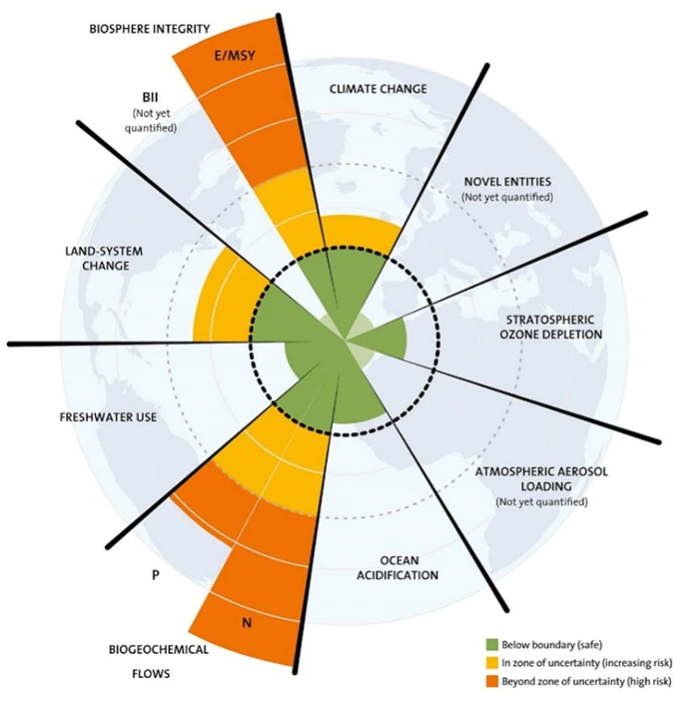For this reason, scientists warn that we are in the middle of the ‘sixth mass extinction’. Research undertaken by the Stockholm Resilience Centre analyses threats to what they have termed ‘planetary boundaries’. They define these boundaries as nine processes through which humans can ‘regulate the stability and resilience of the Earth system’. Within these boundaries, the planet can continue to thrive and cater to the needs of humanity.
Figure 1 shows the state of our Earth according to this research. You can see that biosphere integrity measured by the extinction rate (extinctions per million species/years (E/MSY)) is at high risk and has already passed the boundary of uncertainty. As biogeochemical flows (nitrogen and phosphorus) have also passed the boundaries, we do not know how ecosystems will react.
Figure 1 | Boundary threats to biosphere integrity

Source: Stockholm University1
According to this research, these two issues provide even bigger uncertainties than climate change. However, combatting global warming remains very important, as it ranks high on the list of direct drivers of biodiversity loss, and it increasingly aggravates the negative impact of other drivers, such as land use change, on nature.
What is the role of the financial industry?
Research conducted by De Nederlandsche Bank (DNB) and the PBL Netherlands Environmental Assessment Agency identify “EUR 81 billion in loans provided by Dutch financial institutions to high nitrogen-emitting sectors, and a EUR 28 billion exposure to companies that operate in protected or high conservation value (HCV) regions and face potential stranded assets risks”.2
This is an example of the interconnectedness of Dutch and other financial institutions to high-emitting and biodiversity-threatening industries. On the one hand, this confirms their negative role in reaching planetary boundaries of uncertainty. On the other hand, it highlights the risks they face if legislation or consumer behavior changes on this topic.
Next to this, biodiversity loss is posing a systemic risk, of which investors should become aware. As we find ourselves at the doorstep of the sixth mass extinction, both businesses and regulators have a huge role to play in shifting paradigms about who pays for the externalities created by ‘business-as-usual’.
Frontrunners in ESG are working together on this topic
Many investors are currently focusing on climate change and developing metrics to measure, manage and monitor climate risks and opportunities in their portfolios. However, given the growing body of evidence on the large impact that biodiversity loss will have globally, we believe more effort should be put into measuring the biodiversity impact of portfolios.
In the Netherlands, several investors under leadership of the ASN bank are collaborating in the Partnership for Biodiversity Accounting Financials (PBAF) to develop such metrics. They aim to create a framework for financial institutions to consider and address the biodiversity impact of their portfolios across asset classes.
Furthermore, Robeco started an engagement theme on biodiversity earlier this year. Land use change is one of the major contributors to biodiversity loss, and much of this is driven by crop commodity production. Therefore, our engagement will focus on the impact on biodiversity of deforestation that is linked to five high-risk crop commodities – cocoa, natural rubber, soy, beef, and tropical timber and pulp.
Our engagement centers around five issues. The first three engagement objectives will focus on environmental management, with a clear value placed on ‘zero deforestation’ commitments, biodiversity impact assessments, fauna and flora restoration and conservation, and circular economy principles within companies’ production lines. We deem these highly relevant, especially for the five commodities that fall under this engagement.
The fourth objective will address disclosures, certifications and traceability. The fifth will focus on the social aspect of the production of these commodities, and will tackle both community and land rights, along with labor rights. We want to steer towards reaching 100% traceability for producers and users of these chains. Only then will it be possible to trace the impact on biodiversity in the supply chain.
Call to action: join the Biodiversity pledge
On 25 September the Finance for Biodiversity Pledge will be launched during the Nature for Life Hub at the 75th UN General Assembly. The organizations that have signed the pledge have committed to protecting and restoring biodiversity through their financial activities and investments.
As one of the signatories, Robeco is extending a firm ‘call to arms’ to other investors to sign up. Then they can make sure they are not part of a problem which is already testing the Earth’s ability to digest it.
By signing the pledge, institutions commit to collaborating and sharing knowledge, engaging with companies, assessing impact, setting targets and report publicly on progress. This entails a roadmap that will take up several years, requiring commitment and resources from as many investors as possible. More information on the pledge can be found here.
Make it happen!
SI Opener: Seeing is believing.
免責聲明
本文由荷宝海外投资基金管理(上海)有限公司(“荷宝上海”)编制, 本文内容仅供参考, 并不构成荷宝上海对任何人的购买或出售任何产品的建议、专业意见、要约、招揽或邀请。本文不应被视为对购买或出售任何投资产品的推荐或采用任何投资策略的建议。本文中的任何内容不得被视为有关法律、税务或投资方面的咨询, 也不表示任何投资或策略适合您的个人情况, 或以其他方式构成对您个人的推荐。 本文中所包含的信息和/或分析系根据荷宝上海所认为的可信渠道而获得的信息准备而成。荷宝上海不就其准确性、正确性、实用性或完整性作出任何陈述, 也不对因使用本文中的信息和/或分析而造成的损失承担任何责任。荷宝上海或其他任何关联机构及其董事、高级管理人员、员工均不对任何人因其依据本文所含信息而造成的任何直接或间接的损失或损害或任何其他后果承担责任或义务。 本文包含一些有关于未来业务、目标、管理纪律或其他方面的前瞻性陈述与预测, 这些陈述含有假设、风险和不确定性, 且是建立在截止到本文编写之日已有的信息之上。基于此, 我们不能保证这些前瞻性情况都会发生, 实际情况可能会与本文中的陈述具有一定的差别。我们不能保证本文中的统计信息在任何特定条件下都是准确、适当和完整的, 亦不能保证这些统计信息以及据以得出这些信息的假设能够反映荷宝上海可能遇到的市场条件或未来表现。本文中的信息是基于当前的市场情况, 这很有可能因随后的市场事件或其他原因而发生变化, 本文内容可能因此未反映最新情况,荷宝上海不负责更新本文, 或对本文中不准确或遗漏之信息进行纠正。

